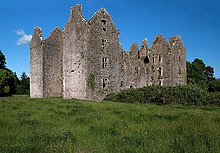Burncourt Castle
| Burncourt Castle | ||
|---|---|---|
|
Burncourt Castle |
||
| Alternative name (s): | At Chúirt Dóite, Everard's Castle, Clogheen Castle | |
| Creation time : | 1641 | |
| Castle type : | Niederungsburg | |
| Conservation status: | ruin | |
| Standing position : | Irish nobility | |
| Construction: | Quarry stone | |
| Place: | Ballyporeen | |
| Geographical location | 52 ° 18 '54.4 " N , 8 ° 4' 11.7" W | |
| Height: | 74 m ASLTemplate: height / unknown reference | |
|
|
||
Burn Court Castle ( Irish An Chúirt DOITE ) is the ruin of a solid house 5.4 km northwest of the village Ballyporeen in Irish County Tipperary . The ruin on the west bank of the Tar is a national monument .
history
The castle was originally called Everard's Castle ; Richard Everard, 1st Baronet , († 1650), son of the politician and judge Sir John Everard , had it built. When Richard Everard married Catherine Plunkett in 1620, his father bequeathed him a large estate around the River Tar.
Around 1639 Sir Richard had a permanent house built on part of this land. It was completed in 1641 and had 26 gables and seven chimneys . During archaeological excavations, a cattle skeleton was found in a shaft that extended under the eastern wall of the permanent house. The cow appears to have been killed and dismembered to be buried there as a protective votive offering - its flanks were found next to each other and its head on the upper spine .
The Everards moved into the castle just as the Irish Rebellion began. In 1642 Sir Richard joined the Catholic Confederate in Kilkenny and became a member of the Supreme Council . His wife stayed in the castle.
In 1649, when Cromwell's Roundheads were advancing on Everard's Castle, Lady Catherine burned it down; hence the name Burned Court .
Sir Richard Everard took part in the Siege of Limerick 1650-1651, was captured by Henry Ireton , and in 1651 hanged. Burncourt Castle was abandoned. It is said that Burncourt Castle took seven years to build, that it was inhabited for seven years, and that it burned for seven days.
At the beginning of the 18th century, the painter Anthony Chearnley had a house built on the ruins of Burncourt Castle.
The excavations also showed that there is no remaining rubble from the castle's fire to this day, which suggests that the slate roofing and the leaden gutters were rescued or stolen for use elsewhere.
description
Die Niederungsburg consists of a rectangular central block and large, square towers at each corner.
While Burncourt Castle is an architecturally impressive building, there is little of great interest there other than the long line of consoles above the south-facing entrance and the floral motifs on the canopy above the entrance.
Burncourt Castle is in a large, solid house with gables and a central block with four bays and four floors, a basement, two full floors and an attic.
It has four large square-plan flanking towers , each five stories high. Consoles for machicolations are attached along the front facade , which are distributed over the full width of the facade. In the middle of the facade is a beautiful entrance door with a roof and ornate signs. The castle is equipped with coupled windows with skylights, which also have beautiful roofs. There are open chimneys in the east wall, in the north wall and in the flanking towers.
Parts of the enclosure with a corner tower can still be seen near the castle today.
The basement floor was paved with pebbles of irregular size and covered an area of 71.6 m². The ceiling of the cellar is 2.37 meters high.
Individual evidence
- ↑ Context: Burnt Court Castle, 1740 [Burncourt Castle, Co. Tipperary ] . National Library of Ireland. Retrieved May 15, 2019.
- ↑ 8 of 365 pix - Places to visit in Tipperary - Burncourt Castle - My Blog . Archived from the original on February 13, 2017. Retrieved May 15, 2019.
- ^ David Sweetman: Medieval Castles of Ireland . Collins Press. January 1, 1999. Retrieved May 15, 2019.
- ↑ Jessica Smyth: Settlement in the Irish Neolithic: New discoveries at the edge of Europe . Oxbow Books. May 29, 2014. Retrieved May 15, 2019.
- ↑ Burn Court Castle, Co. Tipperary . In: Abandoned Ireland . Retrieved May 15, 2019.
- ↑ Castles of Ireland - Burn Court Castle . In: Britain Ireland Castles . Retrieved May 15, 2019.
- ↑ Burn Court Castle, Co. Tipperary . In: Nobody Home - Forgotten Buildings of Ireland . Archived from the original on March 29, 2018. Retrieved May 15, 2019.
- ↑ S. O'Brien: Burn Court Castle . Flickr. 2011. Retrieved May 15, 2019.
- ↑ Burn Court Castle . In: Irish Antiquities . Retrieved May 15, 2019.
- ↑ Burn Court . In: Visit Ballyhoura . April 17, 2012. Retrieved May 15, 2019.
- ↑ 2005: 1402 - Burncourt Castle, Burncourt, Tipperary . In: Excavations.ie . Retrieved May 15, 2019.
- ^ Francis H. Tuckey: The County and City of Cork Remembranced: Or, Annals of the County and City of Cork . O. Savage and Son. January 1, 1837. Retrieved May 15, 2019.


